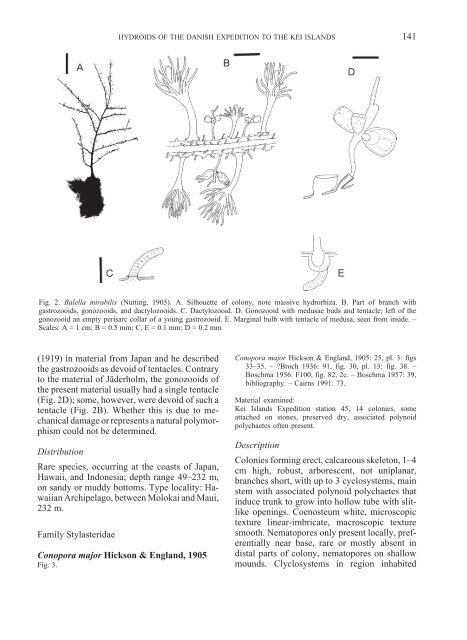Hydroids (Cnidaria, Hydrozoa) of the Danish expedition to
Hydroids (Cnidaria, Hydrozoa) of the Danish expedition to
Hydroids (Cnidaria, Hydrozoa) of the Danish expedition to
Create successful ePaper yourself
Turn your PDF publications into a flip-book with our unique Google optimized e-Paper software.
HYDROIDS OF THE DANISH EXPEDITION TO THE KEI ISLANDS<br />
Fig. 2. Balella mirabilis (Nutting, 1905). A. Silhouette <strong>of</strong> colony, note massive hydrorhiza. B. Part <strong>of</strong> branch with<br />
gastrozooids, gonozooids, and dactylozooids. C. Dactylozooid. D. Gonozooid with medusae buds and tentacle; left <strong>of</strong> <strong>the</strong><br />
gonozooid an empty perisarc collar <strong>of</strong> a young gastrozooid. E. Marginal bulb with tentacle <strong>of</strong> medusa, seen from inside. –<br />
Scales: A = 1 cm; B = 0.5 mm; C, E = 0.1 mm; D = 0.2 mm<br />
(1919) in material from Japan and he described<br />
<strong>the</strong> gastrozooids as devoid <strong>of</strong> tentacles. Contrary<br />
<strong>to</strong> <strong>the</strong> material <strong>of</strong> Jäderholm, <strong>the</strong> gonozooids <strong>of</strong><br />
<strong>the</strong> present material usually had a single tentacle<br />
(Fig. 2D); some, however, were devoid <strong>of</strong> such a<br />
tentacle (Fig. 2B). Whe<strong>the</strong>r this is due <strong>to</strong> mechanical<br />
damage or represents a natural polymorphism<br />
could not be determined.<br />
Distribution<br />
Rare species, occurring at <strong>the</strong> coasts <strong>of</strong> Japan,<br />
Hawaii, and Indonesia; depth range 49–232 m,<br />
on sandy or muddy bot<strong>to</strong>ms. Type locality: Hawaiian<br />
Archipelago, between Molokai and Maui,<br />
232 m.<br />
Family Stylasteridae<br />
Conopora major Hickson & England, 1905<br />
Fig. 3.<br />
141<br />
Conopora major Hickson & England, 1905: 25, pl. 3: figs<br />
33–35. – ?Broch 1936: 91, fig. 30, pl. 13: fig. 38. –<br />
Boschma 1956: F100, fig. 82, 2c. – Boschma 1957: 39,<br />
bibliography. – Cairns 1991: 73.<br />
Material examined:<br />
Kei Islands Expedition station 45, 14 colonies, some<br />
attached on s<strong>to</strong>nes, preserved dry, associated polynoid<br />
polychaetes <strong>of</strong>ten present.<br />
Description<br />
Colonies forming erect, calcareous skele<strong>to</strong>n, 1–4<br />
cm high, robust, arborescent, not uniplanar,<br />
branches short, with up <strong>to</strong> 3 cyclosystems, main<br />
stem with associated polynoid polychaetes that<br />
induce trunk <strong>to</strong> grow in<strong>to</strong> hollow tube with slitlike<br />
openings. Coenosteum white, microscopic<br />
texture linear-imbricate, macroscopic texture<br />
smooth. Nema<strong>to</strong>pores only present locally, preferentially<br />
near base, rare or mostly absent in<br />
distal parts <strong>of</strong> colony, nema<strong>to</strong>pores on shallow<br />
mounds. Clyclosystems in region inhabited

















